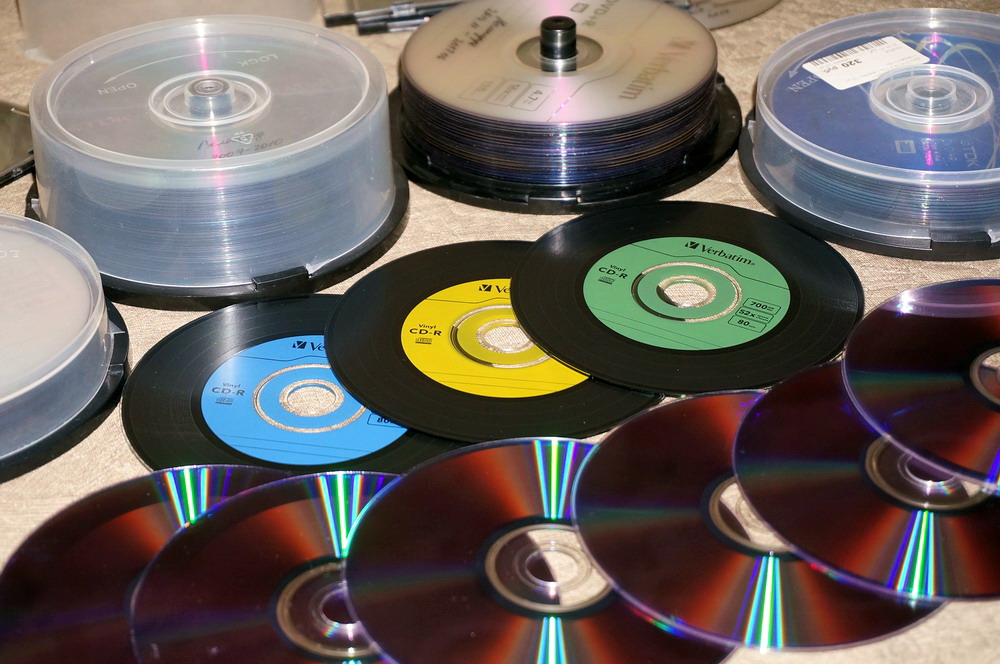
My first digital camera appeared 14 years ago. Then there was the problem of storing photos. Fortunately, at that time she decided to quickly and unequivocally - write to disk, period. External HDDs, and internal ones too, were expensive. SSD-drives, in my opinion, did not exist at all, and if they did, then they probably cost an order of magnitude more expensive. Keeping the footage right on the memory cards and buying a new card every time is wasteful insanity. In general, at home, there was simply no reasonable alternative to DVDs. In addition, there were many games on the discs, and a DVD drive was mandatory on the computer. I immediately had a writing drive.
At some point, and this was about 2-3 years ago, I came to a friend with a car simulator recorded on a DVD-RW disk for him and found that there was no disk reader in his new computer at all. I was a little shocked. A friend laughed: to come with a drive is the same as to come to a car race on a horse with a cart. And then I realized that the era of CD-DVD was leaving. Then I had to buy a large flash drive for data transfer.

But so far I have not been able to abandon the DVD to store my photos. I just do not see a worthy alternative. Some argue that disks are a very unreliable storage because they begin to “crumble” in 3-5 years. Let's see if this is so. 14 years have passed since my first photographs. We take out those old disks from the desk drawer.
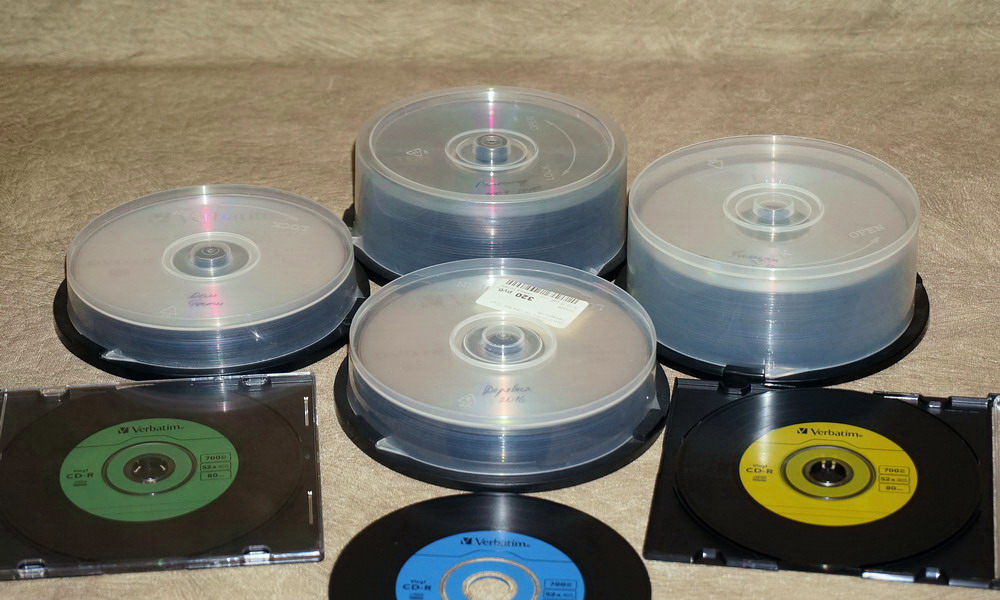
Actually, here is my entire archive. This is 82 DVD + R-disc, which is approximately 360 GB in volume. A few CD-Rs in boxes - they don’t count, I just put them nearby because they look cool - they are in the form of old records, I once bought them, but I didn’t write anything to them.
Why does the archive take so little? Well, before I had the simplest camera and the pictures “weighed” very little. In addition, I am not a professional photographer and never store RAW. The entire archive is just some kind of family photos, moments of various trips, events and feasts. All this does not pretend to be some kind of high art, it’s just such a “home photo album”, something that is as expensive as memories. Well, before recording photos are subjected to strict censorship (a joke): only those pictures that turned out to be more or less interesting and without duplicates are allowed on the disc.



Let's try to read old discs. I changed a few DVD burners, but they were all NEC, Sony or Sony-NEC or something like that. In any case, I remember only these two brands. And I did not skimp on the disks for my photos and always bought expensive ones: usually Verbatim and sometimes TDK.
Disc 1
So. The first disc of the archive is bicycle rides.

The disk was read without problems. Photos on it date back to 2007-2010, and it was recorded in April 2011. Not so he turned out to be ancient.
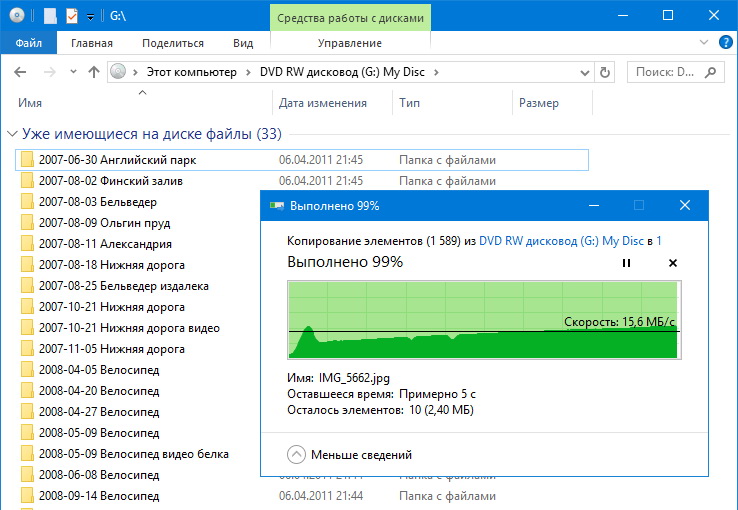
I even remember how I scattered those photos into folders, and then immediately wrote them to disk and deleted them from the HDD. In my opinion, before that they were stored on several CDs, but, unfortunately, I threw them away.







Disc 2
Let's try to find something more ancient. The next disc is the first of a series of trips: “Trips 2005-2007”.

It is logical to assume that his record was made no earlier than 2007. Open the disk. Folders from December 2008. Yes, I remember how I created them and rolled them on a blank.

Well, okay, 11 years old is also good. Apparently, earlier these photos were also stored on CD-ROMs. For this DVD: 11 years - normal flight.





Disc 3
And here is an interesting instance. These are videos that friends recorded. I was not on those trips, I just asked the disk to rewrite.
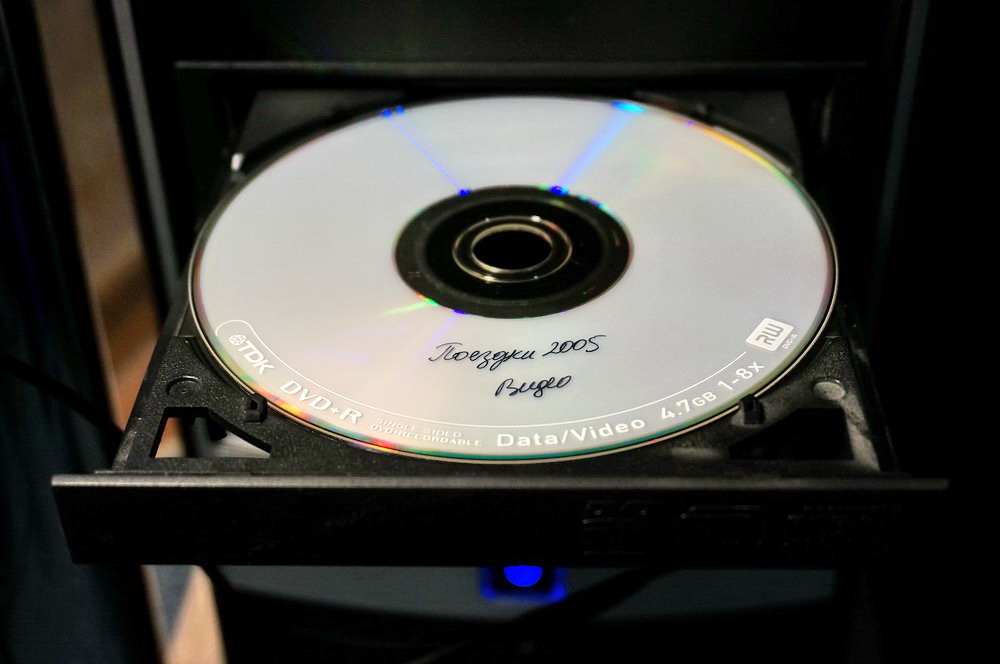
This disk is exactly the year 2005, because I absolutely could not afford to store such a volume on my hard drive at that time. The disk was copied for a long time, about 20 minutes, but it was copied!
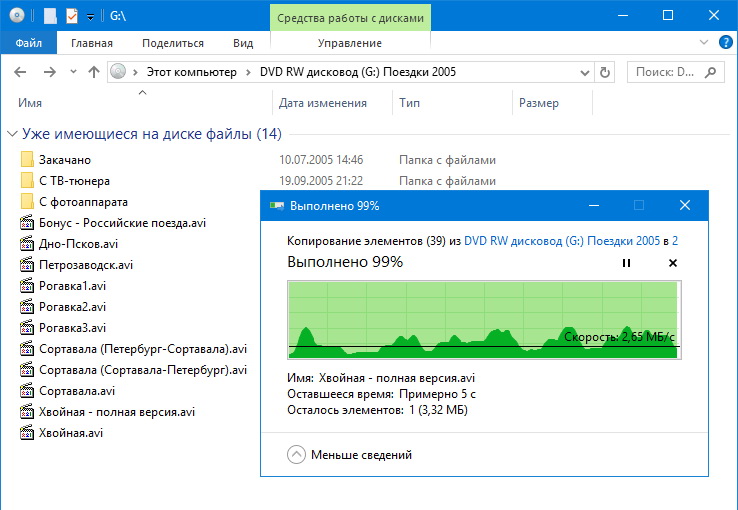
It’s probably time to backup it. However, I remember that even then, right after the recording, it was somehow not read very quickly: apparently, it was with some kind of defect. But I could take these videos from friends again at any time, so I did not spoil another disc.
10 more discs
Unfortunately, I did not find more ancient disks. I tested another 10 random disks from the archive, trying to take the oldest ones, which corresponded to 2007-2010. Without exception, all of them were read without hesitation and errors.
I must say that I always recorded discs at 6x, because I heard that at higher speeds they can be burned more sloppy.




DVD photo storage
What are the disadvantages of this?
- Low access speed. However, for archives with access frequencies on average once a year, this is not critical.
- Media degradation. Here - it depends on the quality of the discs and drive taken and at what speed to record. My discs, more than 10 years old, read without problems. Maybe someone has older ones? Share your experience. And I'm not at all sure that, for example, the magnetic recording used in all other types of media is better than the physical burning of recesses in the surface. Manufacturers of SSDs give a guarantee of data safety from 10 years. A DVD-ROM - up to 50 years or more. But here we are referring, of course, to high-quality DVDs, not “three-kopecks”. It's just that at a price of 40 rubles you should not save some pathetic 10-15 rubles on future memories.
- Low disk space. To record photoshoots from one or two trips, this is enough. And in my case, trips and other reasons for photographing happen no more than once a month. In addition, there is a rule "do not put all the eggs in one basket." To break one of the 82 discs is not so pathetic as to completely burn down the entire storage.
- The fragility of the media. And, in fact, why check them for strength? I always store disks in a box with a spindle, in which they are sold in 10, 25, 50 or 100 pieces. Actually, they are recorded and sent to the same box. And she is already strong enough. I sat on it and stepped on it, it fell to the floor, and there was nothing to the discs.
- A clear advantage: DVD media itself is a disc without any electrics or moving parts. Recording is done by physically burning recesses on one of the disc layers. More reliable - only rock art. And if the DVD drive breaks down, then you can just buy a new one, that is, I mean, the storage medium, unlike a hard drive or an SSD, is not directly attached to the reader.
- If the disc starts to read poorly, then there is still a chance to copy it all the same, even if it takes about 20-30 minutes. What does not always work with a dead “screw."
- Finally, I often hear that DVDs are morally obsolete. Oh, you don’t need just this, okay? For me, the fact that someone said that this thing is no longer fashionable is not a reason to immediately abandon it: it has undeniable advantages, and I want to use them, why not?





Storage of photos on HDD / SSD / memory card
Why not store all the photos on your HDD / SSD? Yes, I understand that today an even larger SSD is cheaper than all my DVDs combined. But, firstly, my discs were bought gradually, as needed. And secondly, an entire HDD or SSD exclusively for a photo was always an expensive one-time purchase. And even if such money appeared at some point, it was always spent on something else such as a new video card, additional RAM, and so on. I wonder if there are others like me? Moreover, at some time I generally switched from HDD to SSD due to the higher speed and stopped recognizing HDD at all. Well, since my HDD was already old, I did not dare to use it even for archives. And drives of a new kind, that is, SSDs, cost more and again seemed like some kind of expensive purchase, like HDD once. They also became unrealistic to buy purely under the archive: to fit everything you need that previously lay on the HDD ...
But if we put aside financial difficulties and look at storage from a technical point of view, then the disadvantages of storage on HDD / SSD, compared to DVD, include:
- Ability to accidentally delete files.
- Possible damage to the electrics of the device, and even with it information, when turning on / off / power surge.
- Exposure to viruses.
- Low durability of storage, since the recording is based on the magnetic principle.
Cloud photo storage

Perhaps these are my prejudices, but something I do not trust the cloud services in terms of long-term archiving. Disadvantages compared to DVD:
- The account in the cloud service may be blocked or the service may be completely closed.
- Some services may require some kind of rights to your photos, such as using them for your learning algorithms or for something else.
- The annual payment may be 4000 or more rubles.
- The server crash can also be written in a small minus, although, I hope, there all the information is duplicated many times. But one cannot be 100% sure of this, nevertheless ...
- If there are some too personal photos, then it is not very pleasant when they generally leak somewhere on the Internet.
Storing photos on your own RAID / own server
By controlling the process yourself, you can be more confident in the safety of information. But - the cost of replacing failed media, a waste of time on software configuration. And, again, the type of carrier is basically the same as in the cloud.
Storing photos on paper
Actually, I don’t see any special advantages over DVD here. Paper also degrades over time. But, in the case of paper, when printing photos there is an extra data conversion. Digital images are transferred to analog. Unless, of course, you store them in numbers on punch cards ...
Conclusion
In general, I have not found a decent replacement DVD. And the point is not that I do not like magnetic media in terms of long-term storage of information, but that working with them requires more effort than recording blanks: you need to register somewhere, pay or raise your server or spend money on some additional devices to contain multiple copies, and then connect them and periodically make these same copies ...
Meanwhile, DVD drives are disappearing from sale, as are the discs themselves. It is a pity that such dinosaurs, more reliable than which are only rock paintings, go down in history. After all, basically it was a good idea. However, Sony released cassette audio players right up to 2010, so it is hoped that this whole story with DVD will not sink into oblivion for a long time. And there - you look and invent some new removable media without built-in electrics and not tied to the magnetic principle. Although, perhaps, it’s still worthwhile to save photos in several places, using all modern means at once?
